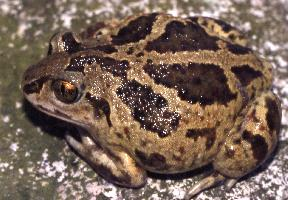
Váhy a míry
| Délka | od 4,2 do 7,2 cm |
|---|
Popis zvířete
The Common Spadefoot (Pelobates fuscus) is an intriguing species of toad found widely across Europe. This amphibian is particularly known for its burrowing habits and its unique adaptations that enable it to thrive in a variety of environments, including grasslands, forest edges, and agricultural areas. The species is characterized by a range of features that distinguish it from other toads and frogs.An adult Common Spadefoot typically measures between 6 to 8 centimeters in length, with females generally being larger than males. Its skin has a smooth texture and is often covered in small tubercles, giving it a somewhat rough appearance. The coloration of the Common Spadefoot can vary but is usually a blend of grey, brown, or olive tones that provide excellent camouflage against the soil and leaf litter of its natural habitat.
One of the most distinctive features of the Common Spadefoot is the black, keratinized 'spade' on each of its hind feet, which it uses to dig into the soil. This adaptation is particularly effective and allows the toad to burrow backwards into the ground where it can hide from predators, escape extreme weather conditions, and enter a state of estivation during periods of drought.
The eyes of the Common Spadefoot are another notable characteristic, with vertical, cat-like pupils that are uncommon among other toad species. These pupils allow for better control of light intake, which is beneficial for an animal that is primarily nocturnal and emerges at night to feed and mate.
The diet of the Common Spadefoot consists mainly of invertebrates such as insects, spiders, and worms. It uses its sticky tongue to catch prey, and its strong jaw muscles help it to consume a variety of prey items. During the breeding season, which typically occurs after heavy rains in the spring or early summer, males call to attract females with a distinctive, low-pitched sound that can be heard from quite a distance.
Females lay their eggs in temporary pools of water, which are essential for the development of the larvae. The tadpoles of the Common Spadefoot are unique in that they have a very rapid growth rate, enabling them to metamorphose into toadlets and leave the water before the temporary pools dry up. This accelerated life cycle is a crucial adaptation for survival in environments where standing water is not always available.
The Common Spadefoot is not considered to be a particularly threatened species, but it is subject to the same environmental pressures as many other amphibians, including habitat loss, pollution, and disease. Conservation efforts for this species include protecting its breeding habitats, monitoring populations, and researching the impacts of environmental change on its life cycle.
In summary, the Common Spadefoot is a fascinating and well-adapted amphibian with a distinctive appearance and life history. Its ability to burrow, specialized diet, and rapid development make it a unique member of the European fauna, and its continued presence in the ecosystem is indicative of a healthy environment.
Nové fotografie zvířat
Top 10 zvířat
- Chinese water dragon (Physignathus cocincinus)
- Galápagos tortoise (Geochelone nigra complex)
- Dolphin gull (Leucophaeus scoresbii)
- Japanese macaque (Macaca fuscata)
- Colombian red howler (Alouatta seniculus)
- Sea urchins (Echinoidea)
- Moustached guenon (Cercopithecus cephus)
- Diana monkey (Cercopithecus diana)
- Common reed warbler (Acrocephalus scirpaceus)
- Common house mosquito (Culex pipiens)